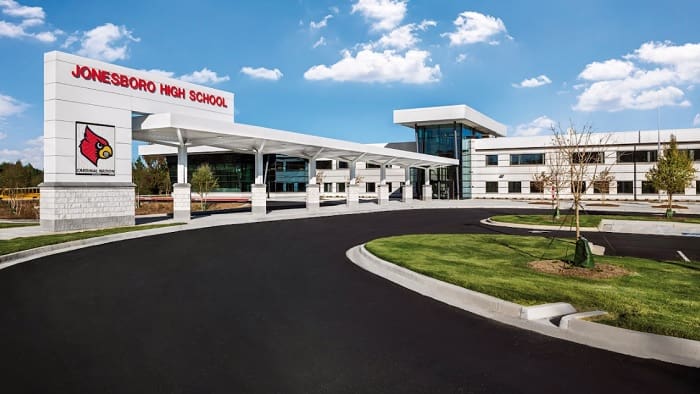
Design firm reimagines metro Atlanta school with improved circulation, motivational art and new identity
In partnership with Clayton County Public Schools and design firm Cooper Carry, Jonesboro High School celebrated its grand re-opening in Aug. 2021, in which half the facility was demolished in phases to make way for new construction, all while the school remained in operation. The project was led by Jerry Cooper, Sophia Tarkhan, Bob Just and Evan Saadat in the K-12 Studio at Cooper Carry. The design team worked in tandem with Board Chair Jessie Goree, Clayton County Board of Education Members and Superintendent Morcease J. Beasley, to create one unified architectural vision that aligned with the district’s vision for education.
New construction for the school included a gymnasium with running track, locker rooms, weight room, cafeteria and kitchen, media center, music suite and classrooms. Other features of the new build include career and job training spaces such as a culinary lab, wood shop, technology lab, mock courtroom, cosmetology, barbering, and health informatics. New administration, counseling, and career counseling suites were specifically designed for faculty to better assist students in a more efficient manner.
“Jonesboro High School was originally constructed in the 1960s and has had many additions over the years, creating a disjointed appearance from the street and making it difficult for students to navigate the school,” said Tarkhan. “This presented an interesting challenge for us, and Clayton County recognized the value of design and importance of establishing a clear identity throughout the school. Cooper Carry collaborated with Clayton County Public Schools facility administrators, Ronick Joseph and Christy Crawford, to provide Jonesboro High with a design that would instill a sense of pride in the students, faculty and administration.”
The design strategy for Jonesboro High School focused on strengthening the school’s presence in the community, improving circulation by internally uniting the structures and upgrading the teaching spaces to meet the needs of students. The school was re-oriented from fronting Mount Zion Boulevard to the higher traffic North McDonough Street, thus improving visibility and exposure. The creation of a Main Street, a double level pedestrian-only corridor running through the middle of the school, connects the existing and new buildings, creating a centralized spine for the school. Main Street is flanked on both sides by two-story glass windows, with visibility of the large courtyards while flooding the school with natural light. The two-story Main Street unites all circulation paths helping students orient themselves throughout the various spaces.
“Main Street is the connection that ties the entire project together,” said Tarkhan. “We seamlessly integrated the remaining structure with the new, to create a cohesive experience within the building. The goal was to visually minimize the difference of what was original and what was new. As well, another goal was to dramatically improve wayfinding throughout the school. No matter where you are, if you can see Main Street, then you can find your way.”
The new front façade of Jonesboro High is anchored on each end with the new cafeteria and media center, enclosed as glass boxes to provide plenty of natural light, which has been proven to increase test scores and improve learning environments. The existing competition gymnasium was demolished and a new competition gymnasium was constructed to offer expanded capacity with a running track, new scoreboards and abundant natural light. The exterior envelope of the school was also upgraded with new insulated walls, high performance glazing and well insulated solar reflective roofs. The school now has a completely new HVAC system along with electrical, life safety and security to reduce energy consumption, while making students safe and secure. Notably, the campus remained completely active during construction.
Also featured throughout the school is the integration of graphic art spotlighting inspirational men and women who have made an impact in the global community. Cooper Carry, Jonesboro administrators and the school district selected historical figures such as Barack Obama, Cesar Chavez, Dalai Lama, Malala Yousafzai, Margaret Thatcher, Martin Luther King, Jr., Oprah Winfrey, Michael Jordan, Serena Williams and more to be featured along the corridors of the school. Quotes such as John F. Kennedy’s “If not us, who? If not now, when?” and Maya Angelou’s “All great achievements require time,” grace the halls with the intention to motivate and inspire the students.
“We are committed to ensuring our vision of innovation and excellence at Clayton County Schools,” said Ronick Joseph, Director of Construction at Clayton County Public Schools. “In working with Cooper Carry, we have established an exceptional learning environment where students can flourish and come to be motivated and inspired on a daily basis. The new Jonesboro High School is another example of the great things that are happening in Clayton County.”
ABOUT Cooper Carry
Cooper Carry provides architecture, planning, landscape architecture, interior design, experiential graphic design, branding and sustainability consulting services. Founded in 1960, the firm specializes in the design of education, government, hospitality, mixed-use, office, residential, restaurants, retail, senior living, science + technology, and transit projects. The firm has designed projects in 45 states and globally in the Caribbean, Middle East, Asia, Africa and Central America. Cooper Carry approaches its work as a collaborative ecosystem. Its multiple studios and services come together daily to provide each project the depth of knowledge needed to meet and exceed objectives. Cooper Carry’s leaders are advocates and authorities for their specialties, empowered by decades of expertise to make decisions that prioritize placemaking, civic space, and the greater good of communities, tenants, residents and visitors. For more information, visit Cooper Carry’s website at coopercarry.com and follow the design firm on Facebook, Instagram, Twitter and LinkedIn.




